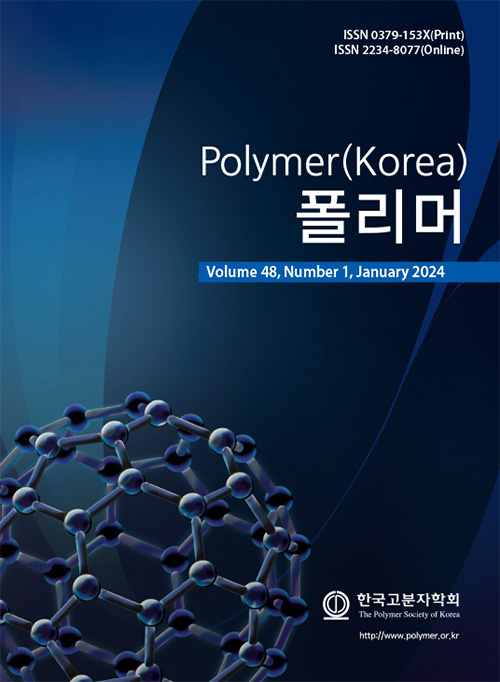- Studies on Optimizing Properties of Self-Healing Polyurethane Resins for Automotive Plastic Parts
Choonho Lee, Woochul Jung, Hakjune Rhee*, **,†
 , and Yongchul Lee*,†
, and Yongchul Lee*,† 
Materials Research & Engineering Center, Hyundai Motor Company, Hwaseong-si, Gyeonggi-do, 18278, Korea
*Department of Applied Chemistry, Hanyang University, Ansan, Gyeonggi-do, 15588, Korea
**Department of Chemical and Molecular Engineering, Hanyang University, Ansan, Gyeonggi-do, 15588, Korea- 자동차 플라스틱 부품용 자가복원 폴리우레탄 수지의 물성 최적화 연구
현대자동차 기초소재연구센터, *한양대학교 응용화학과, **한양대학교 화학분자공학과
Reproduction, stored in a retrieval system, or transmitted in any form of any part of this publication is permitted only by written permission from the Polymer Society of Korea.
A study was conducted to optimize properties of self-Healing polyurethane resins for automotive plastic parts. For the self-healing clear design, polyesterpolyol (PES) and polycarbonate diol (PCD) resins were selected according to the hydroxyl value (%) and the number average molecular weight, and polyurethane resins were synthesized for each resin mixing ratio. The structural analysis and thermal, mechanical, and physical properties of polyurethane resin synthesized by weight mixing ratio were compared and analyzed, and the reliability of the coating film and self-healing ability over time were confirmed to derive the optimal PES / PCD resin content. As a result of measuring the mechanical properties through nano-indentation, the depth under the same indentation load became deeper as the PES resin content increased. This confirmed that the higher the PES resin content, the more soft and highly elastic the coating film was formed. This result could be verified through the results showing that the self-restoring power of the vertical height of the coating surface after the initial scratch recovered to less than 10 mm within 24 hours in the case of urethane resin synthesized with a PES resin content of 6:4 or more.
자동차 플라스틱 부품에 적용할 수 있는 자가복원 폴리우레탄 수지에 대한 물성 최적화 연구를 진행하였다. 자가복원도료 설계를 위하여, hydroxyl value(%) 값과 수평균 분자량에 따른 폴리 에스터 및 폴리카보네이트 수지를 선정하였으며, 각 수지의 혼합비율별 폴리우레탄 수지를 각각 합성하였다. 중량 혼합비율로 합성된 폴리우레탄 수지에 대한 구조 분석 및 열적, 기계적, 물리적 특성을 비교 분석하였으며, 도막의 신뢰성 및 시간에 따른 자가복원 능력을 확인하여 최적의 폴리에스터 와 폴리카보네이트 수지 함량을 도출하였다. 나노 인덴테이션을 통한 기계적 특성을 측정한 결과 폴리에스터 수지 함량이 높아질수록 동일한 압입 하중에서의 깊이가 깊어졌으며, 이는 폴리에스터 수지의 함량이 높아질수록 소프트하면서 탄성이 높은 도막을 형성하고 있다는 것을 확인할 수 있었다. 이 결과는 초기 스크래치 발생 이후 도막 표면의 수직높이에 대한 자가 복원력이 폴리에스터 수지 함량이 6:4 이상으로 합성된 우레탄 수지의 경우 24시간 이내 10 mm 이하로 회복되는 결과를 통해 검증할 수 있었다.
Keywords: thermoset polyurethane, self-healing, nanoindentation, hydroxyl value (%), number average molecular weight.
- Polymer(Korea) 폴리머
- Frequency : Bimonthly(odd)
ISSN 0379-153X(Print)
ISSN 2234-8077(Online)
Abbr. Polym. Korea - 2022 Impact Factor : 0.4
- Indexed in SCIE
 This Article
This Article
-
2024; 48(1): 60-67
Published online Jan 25, 2024
- 10.7317/pk.2024.48.1.60
- Received on Sep 6, 2023
- Revised on Nov 7, 2023
- Accepted on Nov 25, 2023
 Correspondence to
Correspondence to
- Hakjune Rhee*, ** , and Yongchul Lee*
-
*Department of Applied Chemistry, Hanyang University, Ansan, Gyeonggi-do, 15588, Korea
**Department of Chemical and Molecular Engineering, Hanyang University, Ansan, Gyeonggi-do, 15588, Korea - E-mail: hrhee@hanyang.ac.kr, cjohnny@hanyang.ac.kr









 Copyright(c) The Polymer Society of Korea. All right reserved.
Copyright(c) The Polymer Society of Korea. All right reserved.